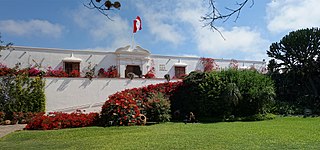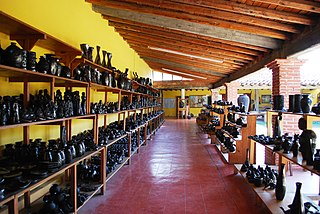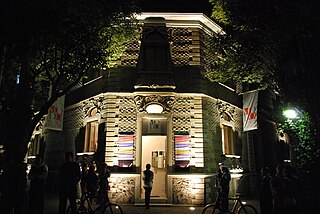
Museo de Arte de Ponce (MAP) is an art museum located on Avenida Las Américas in Ponce, Puerto Rico. It houses a collection of European art, as well as works by Puerto Rican artists. The museum contains one of the most important Pre-Raphaelite collections in the Western Hemisphere, holding some 4,500 pieces of art distributed among fourteen galleries.

The Museo Nacional de Arte (MUNAL) is the Mexican national art museum, located in the historical center of Mexico City. The museum is housed in a neoclassical building at No. 8 Tacuba, Col. Centro, Mexico City. It includes a large collection representing the history of Mexican art from the mid-sixteenth century to the mid 20th century. It is recognizable by Manuel Tolsá's large equestrian statue of Charles IV of Spain, who was the monarch just before Mexico gained its independence. It was originally in the Zocalo but it was moved to several locations, not out of deference to the king but rather to conserve a piece of art, according to the plaque at the base. It arrived at its present location in 1979.

The Franz Mayer Museum, in Mexico City opened in 1986 to house, display and maintain Latin America’s largest collection of decorative arts. The collection was amassed by stockbroker and financial professional Franz Mayer, who collected fine artworks, books, furniture, ceramics, textiles and many other types of decorative items over fifty years of his life. A large portion comes from Europe and Asia but most comes from Mexico itself with items dating from the 15th to the 20th centuries. Many pieces in the collection are fine handcrafts, such as textiles and Talavera pottery, and they are important because they are items that often did not survive because most did not consider them worth preserving.
Luis Camnitzer is a German-born Uruguayan artist, curator, art critic, and academic who was at the forefront of 1960s Conceptual Art. Camnitzer works primarily in sculpture, printmaking, and installation, exploring topics such as repression, institutional critique, and social justice.

The Larco Museum is a privately owned museum of pre-Columbian art, located in the Pueblo Libre District of Lima, Peru. The museum is housed in an 18th-century vice-royal building. It showcases chronological galleries that provide a thorough overview of 5,000 years of Peruvian pre-Columbian history. It is well known for its gallery of pre-Columbian erotic pottery.

The Pre-Columbian Art Museum is an art museum in Cusco, Peru, dedicated to the display of archaeological artifacts and examples of pre-Columbian artworks drawn from all regions of pre-Columbian Peru. The museum is situated on Plazoleta de las Nazarenas in Cusco's San Blas district, and has on permanent display exhibitions of some 450 individual representative artifacts that are drawn from the wider collection of its parent museum, the Larco Museum in the Peruvian capital Lima.

The Chilean Museum of Pre-Columbian Art is an art museum dedicated to the study and display of pre-Columbian artworks and artifacts from Central and South America.

San Bartolo Coyotepec is a town and municipality located in the center of the Mexican state of Oaxaca. It is in the Centro District of the Valles Centrales region about fifteen km south of the capital of Oaxaca.

The Museo Estatal de Arte Popular de Oaxaca or MEAPO is a small museum in the municipality of San Bartolo Coyotepec just south of the city of Oaxaca in Mexico. It is run by the state of Oaxaca to showcase the entity's handcrafts and folk art tradition, through its permanent collection, online "cyber-museum", collaboration with national and international entities, and sponsorship of events such as craft markets, conferences, and temporary exhibitions. It is dedicated to the crafts and to the artisans and the cultures behind the items. Its collection contains samples of most of the crafts produced in the state, especially the Central Valleys region, but most of its collection consists of barro negro pottery, the specialty of San Bartolo Coyotepec. It is run by director Carlomagno Pedro Martínez, a recognized artisan and artist in barro negro.

The Cerralbo Museum is an art museum in Madrid, Spain. It houses the art and historical object collections of Enrique de Aguilera y Gamboa, Marquis of Cerralbo, who died in 1922. It is one of the National Museums of Spain and it is attached to the Ministry of Culture.

The Museo del Objeto del Objeto, or MODO, is a museum in Mexico City and the first museum in Mexico dedicated to design and communications. It was opened in 2010 based on a collection of commercial packaging, advertising, graphic arts, common devices and many other objects dating back to 1810 collected by Bruno Newman over more than 40 years. The museum is dedicated to the preservation of its collection of more than 30,000 items from two centuries and to the research in the history of design and communications.

Centro Cultural Mexiquense is a cultural center located on the western edge of the city of Toluca in central Mexico. The center is run by the State of Mexico government through an agency called the Instituto Mexiquense de Cultura (IMC), the largest and most important of this agency, receiving about 80,000 visitors a year. It contains the Museum of Anthropology and History, the Modern Art Museum and the Museum of Popular Cultures as well as a Central Public Library and the Historical Archives of the State of Mexico, as well as facilities for research.

The National Museum of Ceramics and Decorative Arts "González Martí", is a museum in Valencia, Spain, devoted to ceramics –with special importance to Valencian ceramics–, porcelains and other decorative arts such as textile art, traditional costumes, and furniture. It is one of the National Museums of Spain and it is attached to the Ministry of Culture.

Museu Afro Brasil is a history, artistic and ethnographic museum dedicated to the research, preservation, and exhibition of objects and works related to the cultural sphere of black people in Brazil. It is a public institution held by the Secretariat for Culture of the São Paulo State and managed by the Museu Afro Brasil Association. The museum is located in Ibirapuera Park, a major urban park in São Paulo. The Manoel da Nóbrega Pavilion, designed by Oscar Niemeyer in 1959, houses the Museum. It holds around 6 thousands items and pieces including paintings, sculptures, photos, documents, and archives created between the 15th Century and the present day. The aggregation of pieces includes many works of the African and Afro-Brazilian cultural spheres, ranging from subjects and topics such as religion, labor, and art to the African Diaspora and slavery, whilst registering and affirming the historical trajectory and the African influences in the construction of the Brazilian society. The Museum also offers a diverse range of cultural and didactic activities, temporary expositions, and contains a theater and a specialized library.

The Museum of Sacred Art of São Paulo a museum dedicated to the collection and display of sacred art of Brazil. It is located in the Luz neighborhood of São Paulo in the left wing of the Luz Monastery, a religious institution founded in 1774 by Frei Galvão. The monastery is the only colonial building of the eighteenth century in São Paulo to preserve its original building elements, materials and structure. The monastery was listed as an architectural monument of national importance in 1943 by the National Institute of Historic and Artistic Heritage (IPHAN) and subsequently by the State of São Paulo Council for the Defense of the Historical, Archaeological, Artistic and Touristic Heritage (CONDEPHAAT).

The Museo Leonora Carrington is a museum with venues in the San Luis Potosí City and Xilitla, state of San Luis Potosí, México; dedicated to the surrealist artist Leonora Carrington, the Museo Leonora Carrington San Luis Potosí opened 22 March 2018, with Juan Manuel Carreras as governor of the state. The museum houses a collection of the artist's sculptures, jewelry, engravings, and personal objects; and presents temporary exhibits about surrealism and works influenced by Carrington's work. The collection was donated by Pablo Weisz Carrington, son of the artist, for the creation of the museum.

The Museo de Arte Moderno y Contemporáneo de Santander y Cantabria is an art museum in Santander, Spain. Today the museum specializes in modern and contemporary art.

The Pontevedra Museum is a museum in the Galician city of Pontevedra in Spain. It was founded by the Provincial Deputation of Pontevedra on 30 December 1927 and has six buildings for its exhibitions. It has permanent and temporary exhibition rooms. The museum's collections are multidisciplinary, classified into rooms for painting, sculpture, archaeology, decorative arts, engraving and ethnography.



















